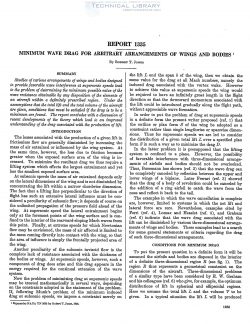naca-report-1335
- Version
- 124 Downloads
- 572.45 KB File Size
- 1 File Count
- November 2, 2016 Create Date
- November 2, 2016 Last Updated
National Advisory Committee for Aeronautics, Report - Minimum Wave Drag for Arbitrary Arrangements of Wings and Bodies

The losses associated with the production of a given lift in
frictionless flow are generally diminished by increasing the
mass of air entrained or influenced by the wing system. At
the same time, however, the loss due to friction becomes
greater when the exposed surface area of the wing is in-
creased. To minimize the resultant drag we thus require a
lifting system which effects the largest entrainment and yet
has the smallest exposed surface area.
At subsonic speeds the mass of air entrained depends only
on the lateral dimensions of the Wing and is not diminished by
concentrating the lift within a narrow chordwise dimension.
The fact that a lifting line perpendicular to the direction of
flight has such an extensive lateral influence must be con—
sidered a peculiarity of subsonic flow; it depends of course on
the unlimited propagation of the pressure field ahead of the
wing. At supersonic speed the lateral entrainment begins
only at the foremost points of the wing surface and is con-
fined to the interior of the rearward-sloping Mach waves from
this point. Finally, at extreme speeds for which Newtonian
flow may be envisioned, the mass of air affected is limited to
the mass coming directly into contact with the wing, so that
the area of influence is simply the frontally projected area of
the wing.
Another peculiarity of the subsonic inviscid flow is the
complete lack of resistance associated with the thiclmess of
the bodies or wings. At supersonic speeds, however, such a
component of drag does arise and this drag appears in the
energy required for the continual extension of the wave
system.
Now the problem of minimizing drag at supersonic speeds
may be treated mathematically in several ways, depending
on the constraints adopted in the statement of the problem.
If, following Munk’s problem of the minimum induced
drag at subsonic speeds, we impose a constraint merely on
the lift and the span of the wing, then we obtain the
same value for the drag at all Mach numbers, namely the
induced drag associated with‘the vortex wake. However
to achieve this value at supersonic speeds the wing would
be required to have an infinitely great length in the flight
direction so that the downward momentum associated with
the lift could be introduced gradually along the flight path,
without appreciable wave formation.
| File | Action |
|---|---|
| naca-report-1335 Minimum Wave Drag for Arbitrary Arrangements of Wings and Bodies.pdf | Download |

Comment On This Post